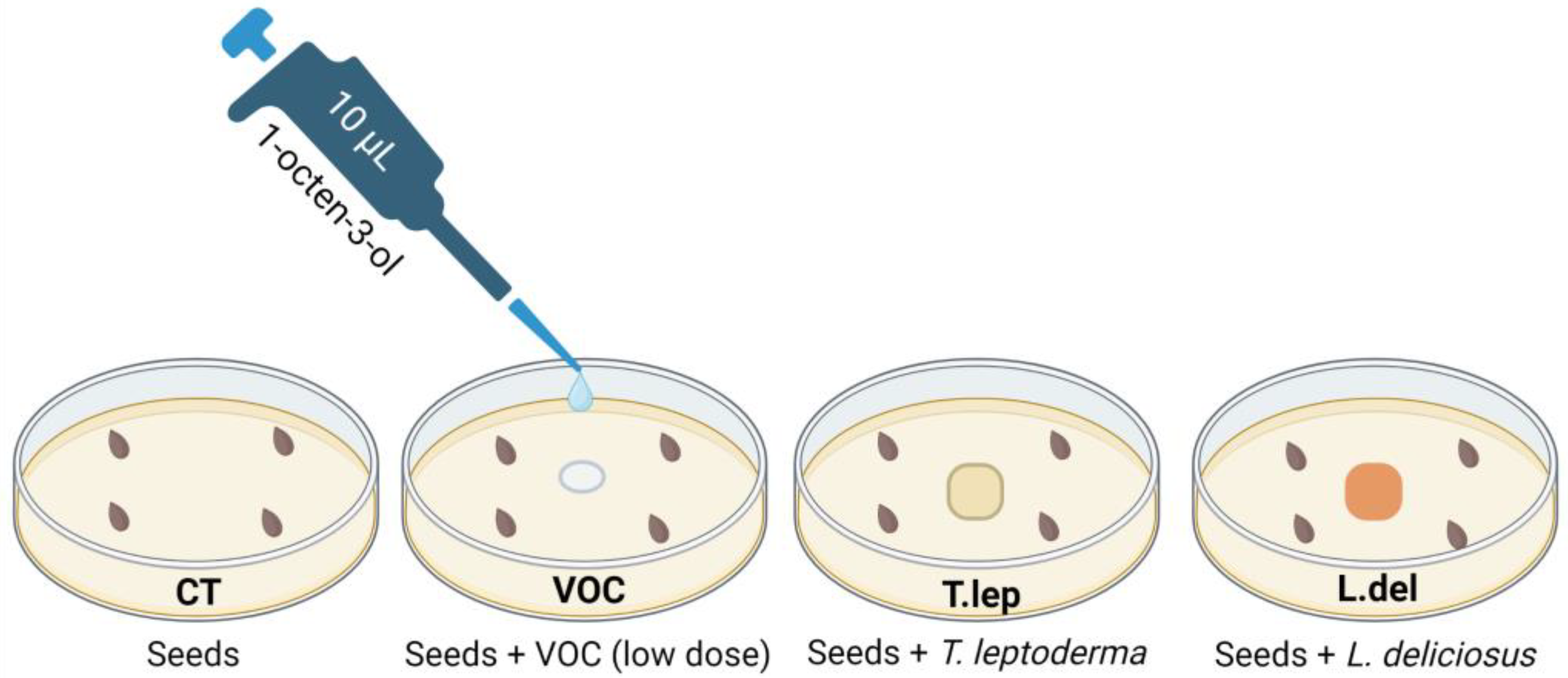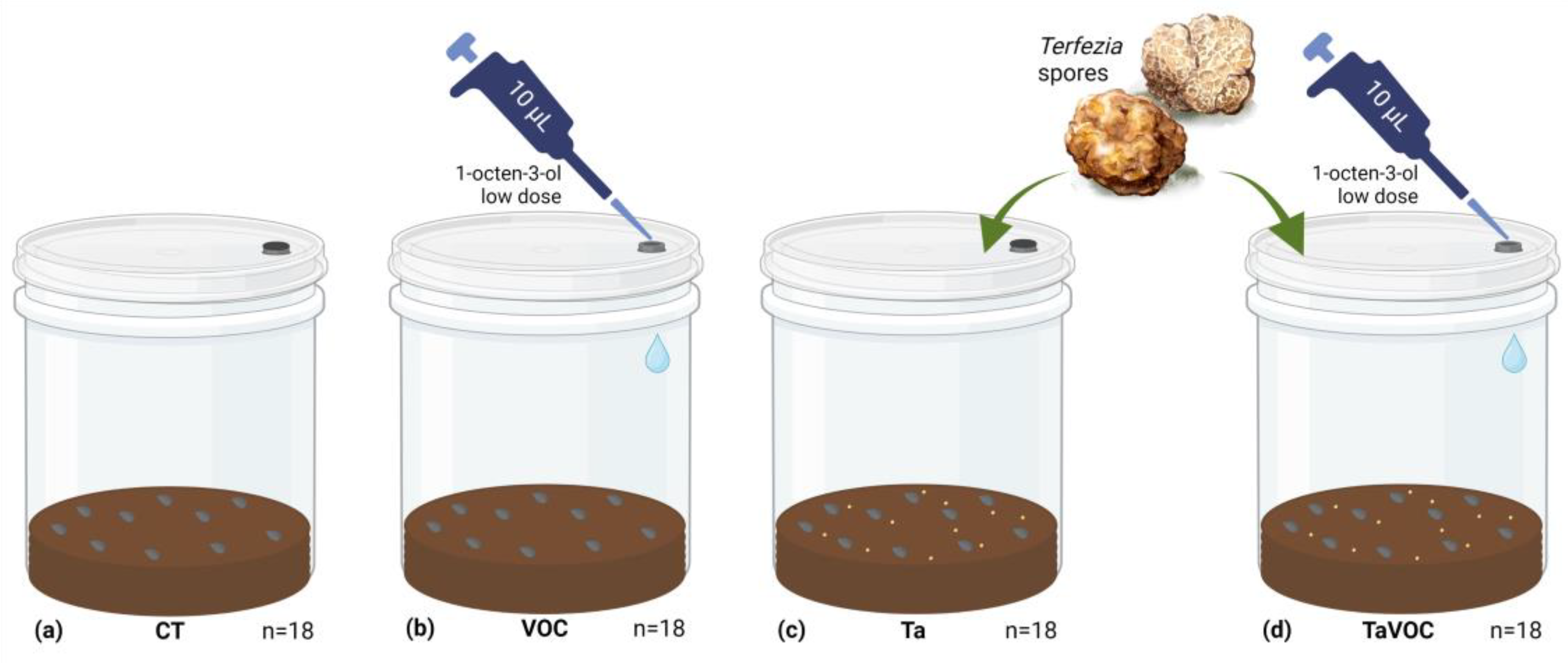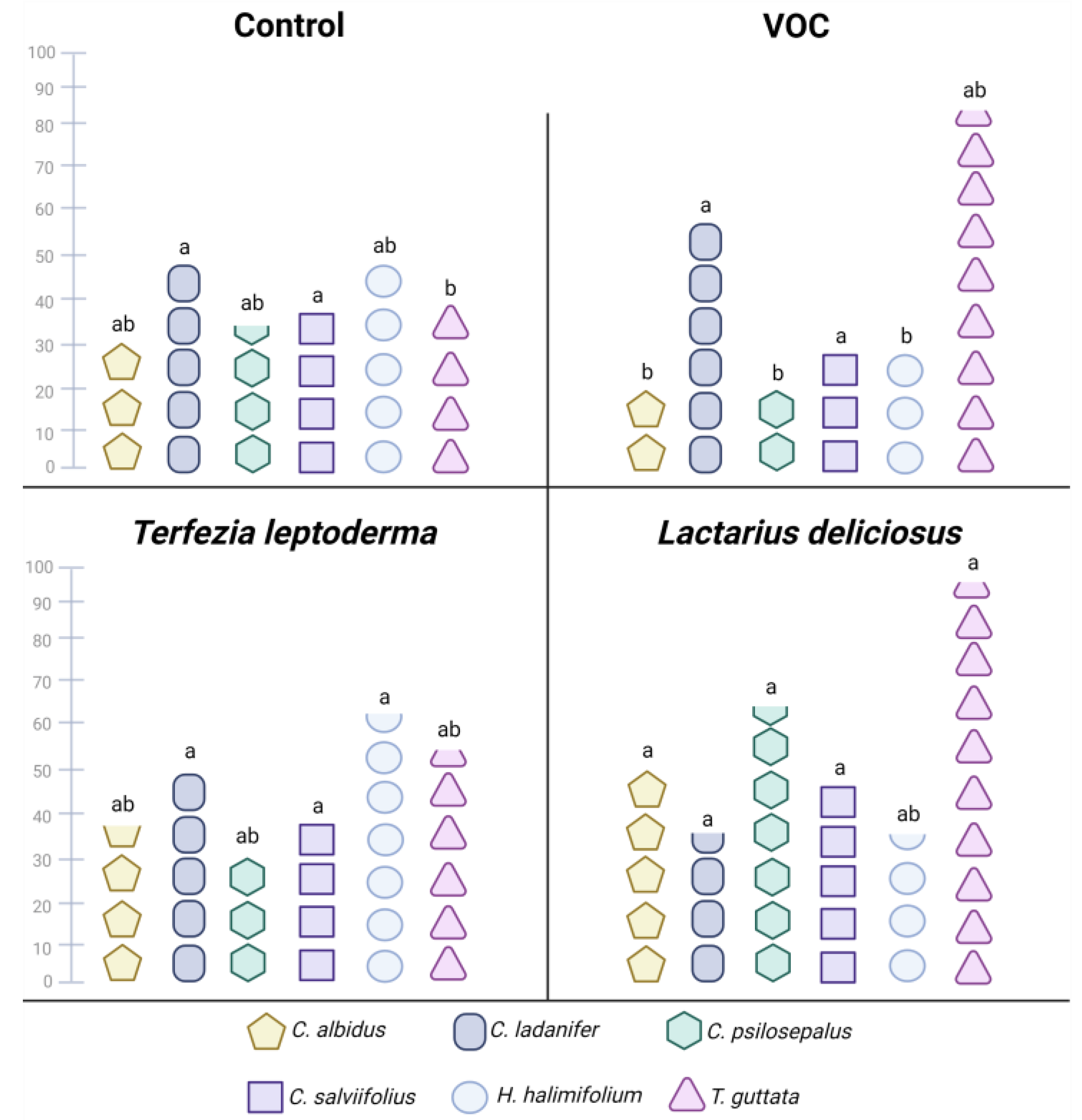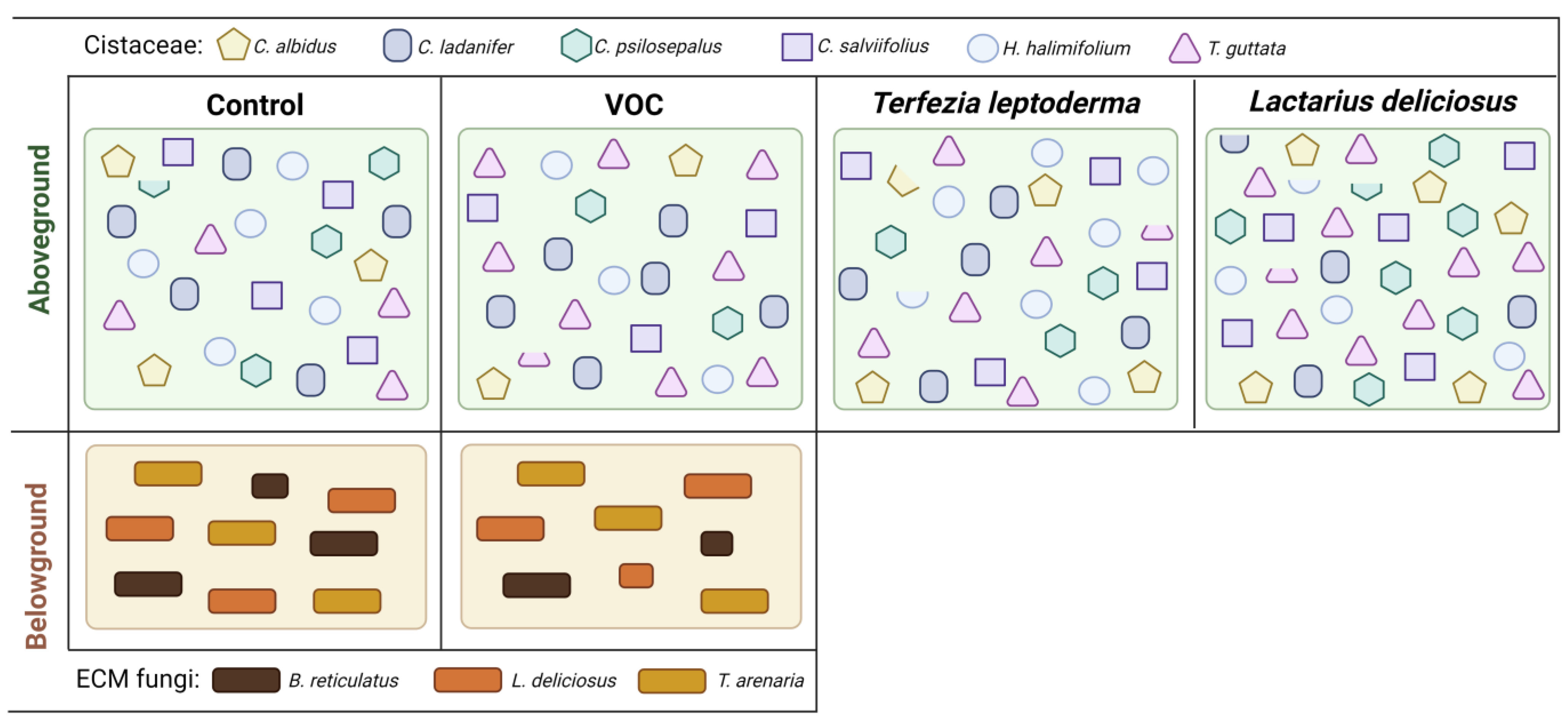The Potential of Ectomycorrhizal Fungi to Modulate below and Aboveground Communities May Be Mediated by 1-Octen-3-ol
Abstract
1. Introduction
2. Materials and Methods
2.1. Fungal Material
2.2. Plant Material
2.3. VOC Assays
2.3.1. Mycelium Development
2.3.2. Effect of VOC and ECM Fungi on Cistaceae Species Germination
2.3.3. Effect of VOC and ECM on Cistus salviifolius Germination and Development
2.4. Statistical Analysis
3. Results
3.1. Mycelium Growth
3.2. Cistaceae Species Germination
3.3. Cistus salviifolius Traits
4. Discussion
5. Conclusions
Supplementary Materials
Author Contributions
Funding
Institutional Review Board Statement
Informed Consent Statement
Data Availability Statement
Acknowledgments
Conflicts of Interest
References
- Nguyen, N.H.; Williams, L.J.; Vincent, J.B.; Stefanski, A.; Cavender-Bares, J.; Messier, C.; Paquette, A.; Gravel, D.; Reich, P.B.; Kennedy, P.G. Ectomycorrhizal Fungal Diversity and Saprotrophic Fungal Diversity Are Linked to Different Tree Community Attributes in a Field-Based Tree Experiment. Mol. Ecol. 2016, 25, 4032–4046. [Google Scholar] [CrossRef] [PubMed]
- Kadowaki, K.; Yamamoto, S.; Sato, H.; Tanabe, A.S.; Hidaka, A.; Toju, H. Mycorrhizal Fungi Mediate the Direction and Strength of Plant–Soil Feedbacks Differently between Arbuscular Mycorrhizal and Ectomycorrhizal Communities. Commun. Biol. 2018, 1, 1–11. [Google Scholar] [CrossRef] [PubMed]
- Quintana-Rodriguez, E.; Rivera-Macias, L.E.; Adame-Alvarez, R.M.; Torres, J.M.; Heil, M. Shared Weapons in Fungus-Fungus and Fungus-Plant Interactions? Volatile Organic Compounds of Plant or Fungal Origin Exert Direct Antifungal Activity in Vitro. Fungal Ecol. 2018, 33, 115–121. [Google Scholar] [CrossRef]
- Moisan, K.; Aragón, M.; Gort, G.; Dicke, M.; Cordovez, V.; Raaijmakers, J.M.; Lucas-Barbosa, D. Fungal Volatiles Influence Plant Defence against Above-Ground and below-Ground Herbivory. Funct. Ecol. 2020, 34, 2259–2269. [Google Scholar] [CrossRef]
- Montesinos-Navarro, A.; Valiente-Banuet, A.; Verdú, M. Mycorrhizal Symbiosis Increases the Benefits of Plant Facilitative Interactions. Ecography 2019, 42, 447–455. [Google Scholar] [CrossRef]
- Deveau, A.; Plett, J.M.; Legué, V.; Frey-Klett, P.; Martin, F. Communication between Plant, Ectomycorrhizal Fungi and Helper Bacteria. In Biocommunication of Fungi; Springer: Dordrecht, The Netherlands, 2012; pp. 229–247. [Google Scholar] [CrossRef]
- Duc, N.H.; Vo, H.T.N.; van Doan, C.; Hamow, K.Á.; Le, K.H.; Posta, K. Volatile Organic Compounds Shape Belowground Plant–Fungi Interactions. Front. Plant Sci. 2022, 13, 4839. [Google Scholar] [CrossRef]
- Werner, S.; Polle, A.; Brinkmann, N. Belowground Communication: Impacts of Volatile Organic Compounds (VOCs) from Soil Fungi on Other Soil-Inhabiting Organisms. Appl. Microbiol. Biotechnol. 2016, 100, 8651–8665. [Google Scholar] [CrossRef]
- Combet, E.; Henderson, J.; Eastwood, D.C.; Burton, K.S. Eight-Carbon Volatiles in Mushrooms and Fungi: Properties, Analysis, and Biosynthesis. Mycoscience 2006, 47, 317–326. [Google Scholar] [CrossRef]
- Contreras-Cornejo, H.A.; Orozco-Granados, O.; Ramírez-Ordorica, A.; García-Juárez, P.; López-Bucio, J.; Macías-Rodríguez, L. Light and Mycelial Injury Influences the Volatile and Non-Volatile Metabolites and the Biocontrol Properties of Trichoderma atroviride. Rhizosphere 2022, 22, 100511. [Google Scholar] [CrossRef]
- Xiong, C.; Li, Q.; Li, S.; Chen, C.; Chen, Z.; Huang, W. In Vitro Antimicrobial Activities and Mechanism of 1-Octen-3-Ol against Food-Related Bacteria and Pathogenic Fungi. J. Oleo Sci. 2017, 66, 1041–1049. [Google Scholar] [CrossRef]
- Chitarra, G.S.; Abee, T.; Rombouts, F.M.; Posthumus, M.A.; Dijksterhuis, J. Germination of Penicillium paneum Conidia Is Regulated by 1-Octen-3-Ol, a Volatile Self-Inhibitor. Appl. Environ. Microbiol. 2004, 70, 2823–2829. [Google Scholar] [CrossRef] [PubMed]
- Chitarra, G.S.; Abee, T.; Rombouts, F.M.; Dijksterhuis, J. 1-Octen-3-Ol Inhibits Conidia Germination of Penicillium paneum despite of Mild Effects on Membrane Permeability, Respiration, Intracellular PH, and Changes the Protein Composition. FEMS Microbiol. Ecol. 2005, 54, 67–75. [Google Scholar] [CrossRef] [PubMed]
- Wang, X.; Huang, M.; Peng, Y.; Yang, W.; Shi, J. Antifungal Activity of 1-Octen-3-Ol against Monilinia fructicola and Its Ability in Enhancing Disease Resistance of Peach Fruit. Food Control 2022, 135, 108804. [Google Scholar] [CrossRef]
- Noble, R.; Dobrovin-Pennington, A.; Hobbs, P.J.; Pederby, J.; Rodger, J.P.A. Volatile C8 Compounds and Pseudomonads Influence Primordium Formation of Agaricus bisporus. Mycologia 2009, 101, 583–591. [Google Scholar] [CrossRef]
- Harman, G.E.; Uphoff, N. Symbiotic Root-Endophytic Soil Microbes Improve Crop Productivity and Provide Environmental Benefits. Scientifica 2019, 2019, 1–25. [Google Scholar] [CrossRef]
- Kamaruzzaman, M.; Wang, Z.; Wu, M.; Yang, L.; Han, Y.; Li, G.; Zhang, J. Promotion of Tomato Growth by the Volatiles Produced by the Hypovirulent Strain QT5-19 of the Plant Gray Mold Fungus Botrytis cinerea. Microbiol. Res. 2021, 247, 126731. [Google Scholar] [CrossRef]
- Schulz-Bohm, K.; Martín-Sánchez, L.; Garbeva, P. Microbial Volatiles: Small Molecules with an Important Role in Intra- and Inter-Kingdom Interactions. Front. Microbiol. 2017, 8, 2484. [Google Scholar] [CrossRef]
- Guo, Y.; Jud, W.; Weikl, F.; Ghirardo, A.; Junker, R.R.; Polle, A.; Benz, J.P.; Pritsch, K.; Schnitzler, J.P.; Rosenkranz, M. Volatile Organic Compound Patterns Predict Fungal Trophic Mode and Lifestyle. Commun. Biol. 2021, 4, 1–12. [Google Scholar] [CrossRef]
- Dickschat, J.S. Fungal Volatiles – a Survey from Edible Mushrooms to Moulds. Nat. Prod. Rep. 2017, 34, 310–328. [Google Scholar] [CrossRef]
- Splivallo, R.; Bossi, S.; Maffei, M.; Bonfante, P. Discrimination of Truffle Fruiting Body versus Mycelial Aromas by Stir Bar Sorptive Extraction. Phytochemistry 2007, 68, 2584–2598. [Google Scholar] [CrossRef]
- Menotta, M.; Gioacchini, A.M.; Amicucci, A.; Buffalini, M.; Sisti, D.; Stocchi, V. Headspace Solid-Phase Microextraction with Gas Chromatography and Mass Spectrometry in the Investigation of Volatile Organic Compounds in an Ectomycorrhizae Synthesis System. Rapid Commun. Mass Spectrom. 2004, 18, 206–210. [Google Scholar] [CrossRef] [PubMed]
- Ferreira, I.; Corrêa, A.; Cruz, C. Sustainable Production of Ectomycorrhizal Fungi in the Mediterranean Region to Support the European Green Deal. Plants People Planet 2023, 5, 14–26. [Google Scholar] [CrossRef]
- Azul, A.M.; Sousa, J.P.; Agerer, R.; Martín, M.P.; Freitas, H. Land Use Practices and Ectomycorrhizal Fungal Communities from Oak Woodlands Dominated by Quercus suber L. Considering Drought Scenarios. Mycorrhiza 2010, 20, 73–88. [Google Scholar] [CrossRef] [PubMed]
- Prieto-Rubio, J.; Garrido, J.L.; Pérez-Izquierdo, L.; Alcántara, J.M.; Azcón-Aguilar, C.; López-García, A.; Rincón, A. Scale Dependency of Ectomycorrhizal Fungal Community Assembly Processes in Mediterranean Mixed Forests. Mycorrhiza 2022, 32, 315–325. [Google Scholar] [CrossRef]
- Leonardi, M.; Furtado, A.N.M.; Comandini, O.; Geml, J.; Rinaldi, A.C. Halimium as an Ectomycorrhizal Symbiont: New Records and an Appreciation of Known Fungal Diversity. Mycol. Prog. 2020, 19, 1495–1509. [Google Scholar] [CrossRef]
- Correia, O.; Ascensão, L. Summer Semi-Deciduous Species of the Mediterranean Landscape: A Winning Strategy of Cistus Species to Face the Predicted Changes of the Mediterranean Climate. Plant Biodivers. Monit. Assess. Conserv. 2017, 195–217. [Google Scholar] [CrossRef]
- Rinaldi, O.C.M.C.A.C.; Comandini, O.; Contu, M.; Rinaldi, A.C. An Overview of Cistus Ectomycorrhizal Fungi. Mycorrhiza 2006, 16, 381–395. [Google Scholar] [CrossRef]
- Albuquerque-Martins, R.; Carvalho, P.; Miranda, D.; Gonçalves, M.T.; Portugal, A. Edible Ectomycorrhizal Fungi and Cistaceae. A Study on Compatibility and Fungal Ecological Strategies. PLoS ONE 2019, 14, e0226849. [Google Scholar] [CrossRef]
- Martins, R.F. Ectomycorrhizal Associations of Edible Fungi and Cistus Spp.: From Eld Studies to in Vitro Synthesis. Master’s Dissertation, Universidade de Coimbra, Coimbra, Portugal, 2016. Available online: http://hdl.handle.net/10316/35162 (accessed on 21 December 2022).
- Águeda, B.; Parladé, J.; de Miguel, A.M.; Martínez-Peña, F. Characterization and Identification of Field Ectomycorrhizae of Boletus edulis and Cistus ladanifer. Mycologia 2006, 98, 23–30. [Google Scholar] [CrossRef]
- Hernández-Rodríguez, M.; Martín-Pinto, P.; Oria-de-Rueda, J.A.; Diaz-Balteiro, L. Optimal Management of Cistus ladanifer Shrublands for Biomass and Boletus edulis Mushroom Production. Agrofor. Syst. 2017, 91, 663–676. [Google Scholar] [CrossRef]
- Bon, M.; Wilkinson, J.; Ovenden, D.W. Guía de Campo de Los Hongos de Europa; Angulo Books: Madrid, Spain, 1988; ISBN 8428208654. [Google Scholar]
- Llamas Frade, B.; Alfonso, T. Guía de Campo de Los Hongos de La Península Ibérica; Celarayn: León, Spain, 2005; ISBN 848971603X. [Google Scholar]
- MycoKey Home. Available online: http://www.mycokey.com/ (accessed on 10 January 2023).
- Splivallo, R.; Novero, M.; Bertea, C.M.; Bossi, S.; Bonfante, P. Truffle Volatiles Inhibit Growth and Induce an Oxidative Burst in Arabidopsis thaliana. New Phytol. 2007, 175, 417–424. [Google Scholar] [CrossRef] [PubMed]
- Okull, D.O.; Beelman, R.B.; Gourama, H. Antifungal Activity of 10-Oxo-Trans-8-Decenoic Acid and 1-Octen-3-Ol against Penicillium expansum in Potato Dextrose Agar Medium. J. Food Prot. 2003, 66, 1503–1505. [Google Scholar] [CrossRef] [PubMed]
- Sawahata, T.; Shimano, S.; Suzuki, M. Tricholoma Matsutake 1-Ocen-3-Ol and Methyl Cinnamate Repel Mycophagous Proisotoma minuta (Collembola: Insecta). Mycorrhiza 2008, 18, 111–114. [Google Scholar] [CrossRef] [PubMed]
- Beltran-Garcia, M.J.; Estarron-Espinosa, M.; Ogura, T. Volatile Compounds Secreted by the Oyster Mushroom (Pleurotus ostreatus) and Their Antibacterial Activities. J. Agric. Food Chem. 1997, 45, 4049–4052. [Google Scholar] [CrossRef]
- Louro, R.; Natário, B.; Santos-Silva, C. Morphological Characterization of the In Vitro Mycorrhizae Formed between Four Terfezia Species (Pezizaceae) with Cistus salviifolius and Cistus ladanifer—Towards Desert Truffles Production in Acid Soils. J. Fungi 2021, 7, 35. [Google Scholar] [CrossRef] [PubMed]
- Kües, U.; Khonsuntia, W.; Subba, S.; Dörnte, B. Volatiles in Communication of Agaricomycetes. Physiol. Genet. 2018, 149–212. [Google Scholar] [CrossRef]
- Vašutová, M.; Mleczko, P.; López-García, A.; Maček, I.; Boros, G.; Ševčík, J.; Fujii, S.; Hackenberger, D.; Tuf, I.H.; Hornung, E.; et al. Taxi Drivers: The Role of Animals in Transporting Mycorrhizal Fungi. Mycorrhiza 2019, 29, 413–434. [Google Scholar] [CrossRef]
- Ditengou, F.A.; Müller, A.; Rosenkranz, M.; Felten, J.; Lasok, H.; Van Doorn, M.M.; Legué, V.; Palme, K.; Schnitzler, J.P.; Polle, A. Volatile Signalling by Sesquiterpenes from Ectomycorrhizal Fungi Reprogrammes Root Architecture. Nat. Commun. 2015, 6, 1–9. [Google Scholar] [CrossRef]
- Leake, J.; Johnson, D.; Donnelly, D.; Muckle, G.; Boddy, L.; Read, D. Networks of Power and Influence: The Role of Mycorrhizal Mycelium in Controlling Plant Communities and Agroecosystem Functioning. Can. J. Bot. 2004, 82, 1016–1045. [Google Scholar] [CrossRef]
- Mahmoudi, N.; Caeiro, M.F.; Mahdhi, M.; Tenreiro, R.; Ulm, F.; Mars, M.; Cruz, C.; Dias, T. Arbuscular Mycorrhizal Traits Are Good Indicators of Soil Multifunctionality in Drylands. Geoderma 2021, 397, 115099. [Google Scholar] [CrossRef]
- Lee, S.; Behringer, G.; Hung, R.; Bennett, J. Effects of Fungal Volatile Organic Compounds on Arabidopsis thaliana Growth and Gene Expression. Fungal Ecol. 2019, 37, 1–9. [Google Scholar] [CrossRef]
- Hung, R.; Lee, S.; Bennett, J.W. The Effects of Low Concentrations of the Enantiomers of Mushroom Alcohol (1-Octen-3-Ol) on Arabidopsis Thaliana. Mycology 2014, 5, 73–80. [Google Scholar] [CrossRef] [PubMed]
- Farag, M.A.; Fathi, D.; Shamma, S.; Shawkat, M.S.A.; Shalabi, S.M.; El Seedi, H.R.; Afifi, S.M. Comparative Metabolome Classification of Desert Truffles Terfezia claveryi and Terfezia boudieri via Its Aroma and Nutrients Profile. LWT 2021, 142, 111046. [Google Scholar] [CrossRef]
- Kishimoto, K.; Matsui, K.; Ozawa, R.; Takabayashi, J. Volatile 1-Octen-3-Ol Induces a Defensive Response in Arabidopsis thaliana. J. Gen. Plant Pathol. 2007, 73, 35–37. [Google Scholar] [CrossRef]
- Hung, R.; Lee, S.; Rodriguez-Saona, C.; Bennett, J.W. Common Gas Phase Molecules from Fungi Affect Seed Germination and Plant Health in Arabidopsis thaliana. AMB Express 2014, 4, 1–7. [Google Scholar] [CrossRef]






| 6 Months | 9 Months | ||||||
|---|---|---|---|---|---|---|---|
| Trait | Treatment | Mean | SD | Mean | SD | ||
| Shoot length (cm) | CT | 4.34 | ±3.14 | 8.91 | ±4.09 | ||
| Ta | 5.63 | ±3.26 | 10.38 | ±4.33 | |||
| TaVOC | 4.83 | ±3.04 | 11.40 | ±4.69 | |||
| VOC | 4.35 | ±2.61 | 7.54 | ±4.29 | |||
| Root length (cm) | CT | 6.11 | ±3.31 | 9.28 | ±4.13 | ||
| Ta | 4.83 | ±2.25 | 7.23 | ±2.88 | |||
| TaVOC | 3.81 | ±1.74 | 6.94 | ±2.47 | |||
| VOC | 4.75 | ±3.22 | 5.94 | ±2.20 | |||
| Shoot fresh weight (mg) | CT | 52.11 | ±46.14 | 99.75 | ±74.21 | ||
| Ta | 86.35 | ±84.16 | 146.93 | ±144.51 | |||
| TaVOC | 149.33 | ±129.22 | 309.02 | ±245.66 | |||
| VOC | 53.80 | ±45.01 | 89.45 | ±82.70 | |||
| Root fresh weight (mg) | CT | 16.84 | ±14.76 | 42.35 | ±40.05 | ||
| Ta | 21.65 | ±20.46 | 46.16 | ±43.21 | |||
| TaVOC | 32.35 | ±31.13 | 58.74 | ±34.40 | |||
| VOC | 12.02 | ±13.01 | 44.85 | ±40.45 | |||
| Branches (No/shoot) | CT | 0.00 | ±0.00 | b | 0.81 | ±0.61 | b |
| Ta | 0.32 | ±0.07 | b | 4.05 | ±3.52 | a | |
| TaVOC | 1.57 | ±0.61 | a | 5.00 | ±4.90 | a | |
| VOC | 0.38 | ±0.09 | b | 1.05 | ±0.74 | a,b | |
| Leaves (No/shoot) | CT | 10.90 | ±5.58 | a | 11.39 | ±5.96 | b |
| Ta | 13.71 | ±5.05 | a | 28.10 | ±19.35 | a | |
| TaVOC | 13.55 | ±5.97 | a | 49.43 | ±39.12 | a | |
| VOC | 12.24 | ±5.64 | a | 13.24 | ±4.88 | a,b | |
Disclaimer/Publisher’s Note: The statements, opinions and data contained in all publications are solely those of the individual author(s) and contributor(s) and not of MDPI and/or the editor(s). MDPI and/or the editor(s) disclaim responsibility for any injury to people or property resulting from any ideas, methods, instructions or products referred to in the content. |
© 2023 by the authors. Licensee MDPI, Basel, Switzerland. This article is an open access article distributed under the terms and conditions of the Creative Commons Attribution (CC BY) license (https://creativecommons.org/licenses/by/4.0/).
Share and Cite
Ferreira, I.; Dias, T.; Cruz, C. The Potential of Ectomycorrhizal Fungi to Modulate below and Aboveground Communities May Be Mediated by 1-Octen-3-ol. J. Fungi 2023, 9, 180. https://doi.org/10.3390/jof9020180
Ferreira I, Dias T, Cruz C. The Potential of Ectomycorrhizal Fungi to Modulate below and Aboveground Communities May Be Mediated by 1-Octen-3-ol. Journal of Fungi. 2023; 9(2):180. https://doi.org/10.3390/jof9020180
Chicago/Turabian StyleFerreira, Inês, Teresa Dias, and Cristina Cruz. 2023. "The Potential of Ectomycorrhizal Fungi to Modulate below and Aboveground Communities May Be Mediated by 1-Octen-3-ol" Journal of Fungi 9, no. 2: 180. https://doi.org/10.3390/jof9020180
APA StyleFerreira, I., Dias, T., & Cruz, C. (2023). The Potential of Ectomycorrhizal Fungi to Modulate below and Aboveground Communities May Be Mediated by 1-Octen-3-ol. Journal of Fungi, 9(2), 180. https://doi.org/10.3390/jof9020180







